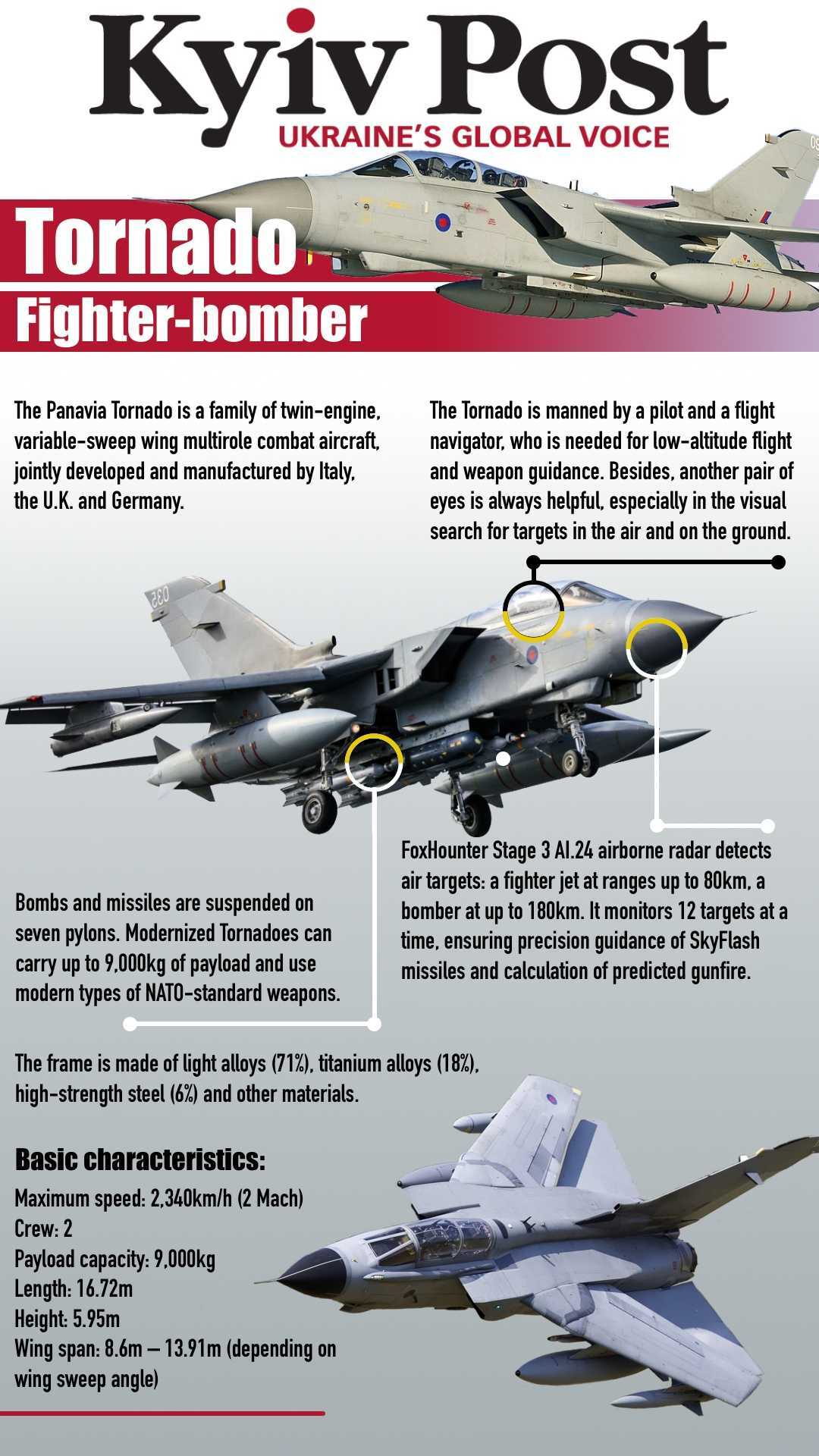Italy has been considering giving fighter jets to Ukraine, according to La Repubblica, but on one condition: Italy will not be the first to do it.
However, Italian Foreign Minister Antonio Tajani was quick to deny the report on the eve of his prime minister Giorgia Meloni’s visit to Kyiv on Feb. 21.
JOIN US ON TELEGRAM
Follow our coverage of the war on the @Kyivpost_official.
But many analysts believe NATO allies will eventually supply Ukraine with airplanes – which require complex and time-consuming training and logistics – once the critical threat of ongoing Russian infantry attacks have been dealt with.
Western Europe’s contribution could, in theory, be significant.
The British-German-Italian-produced Panavia Tornado fighter jets have been in service in the three countries since 1980. They have also been imported to and still actively used in Saudi Arabia.
The Tornado could be called the symbol of the revival of the aircraft-making industry in Western Europe, which managed to overcome the post-WW II recession, dependence on the United States, and the financial difficulties of the 1960s. The Europeans built an A-class fighter jet up to the highest third-generation standards. The closest to it was the MiG-27.
The Tornado was the world’s first serially produced aircraft equipped with an electric flight control system while the traditional mechanical system remained as a duplicate. It was also Europe’s first serially produced variable-sweep wing multirole aircraft.

UK to Speed Up Military Purchases Amid Ukraine Fallout
This jet was jointly developed and manufactured in the early 1970s by the best British, German and Italian aircraft designers and builders, which united in the consortium Panavia Aircraft GmbH. The U.K. and Germany each provided 42.5 percent of funding. Italy provided 15 percent.
The Tornado was made for specific purposes: infantry cover and support, aerial reconnaissance, and destruction of airfields, waterborne targets, command posts and concentrated personnel and materiel. It is also maneuverable enough for air combat and can carry nuclear munitions. Importantly, the Tornado performs equally well in any weather and at any time of day.
Tornadoes were used in the Iraq war in 1991 and in the Balkans in 1999. Although their serial production stopped in 1998, they are still used by Germany, Italy and Saudi Arabia. In the U.K., the last Tornado was decommissioned in 2019 and replaced by the fourth-generation Eurofighter Typhoon.
The Tornado is manned by a pilot and a flight navigator, who is needed for low-altitude flights and weapon guidance. Besides, another pair of eyes is always helpful, especially in the visual search for targets in the air and on the ground.
The Tornado has two IWKA-Mauser 27mm automatic guns with 180 rounds each. The flight navigator can change their firing rate from 1,000 to 1,700 shots per minute – at surface and air targets respectively.
The Tornado can carry up to 9,000-kilograms of payload and use modern types of weapons, including laser-guided bombs BLU-109 and GBU-22 Paveway III, tactical cruise missiles KEPD 350 Taurus and air-to-air missiles IRIS-T. The latter are known in Ukraine where they are fired from IRIS-T air defense systems provided by Germany.
To destroy armored vehicles in urban areas the Tornado uses AGM-65 Maverick missiles. It can also launch AGM-88 HARM antiradar missiles which are already used by the Armed Forces of Ukraine.
This jet has passive means of protection, including heat traps and dipole antiradar reflectors.
It can fly at extremely low altitudes where it is almost invisible to air defense radars and invulnerable to missiles. The autopilot can keep it at 60 meters, following the surface relief. Manually, the pilot can keep it at 30 meters.
The Tornado’s maximum speed is 2,414 km/h, ceiling 17,000 meters, and flight range 1,390 kilometers. It can also be refueled in the air. Depending on specific flight conditions and missions, the wing can be delta or swept, ensuring the desired maneuverability at different speeds and altitudes.

To ensure the optimal speed for a short takeoff or landing, the pilot can “unfold” the wing by 25 degrees and fully open the flaps. In some modifications the backswing angle is changed automatically, thus relieving the pilot.
Two Rolls-Royce RB199 engines ensure the aircraft’s exceptional performance and controllability, especially at low speeds. Thanks to the thrust reversal, it can land on shorter runways and in a shorter time.
For long-range missions the Tornado has additional fuel tanks under the wings and a draw-out refueling receiver. It can be refueled in the air from another Tornado.
There are three primary Tornado variants.
Out of around 900 manufactured Tornado aircraft of various modifications Germany bought 363, Italy 100, and the UK 249. Saudi Arabia bought 120 fighter-bombers.
The Bundeswehr plans to shortly decommission the last 93 Tornadoes and replace them with fifth-generation F35 fighter-bombers. The decommissioned Tornadoes could be of great help to Ukraine in its war against Russia.
Italy could just as well hand its Tornadoes over to Ukraine without reducing its own defense capabilities. That could be synchronized with handovers from Germany and also the UK that decommissioned its Tornadoes several years ago.
You can also highlight the text and press Ctrl + Enter











